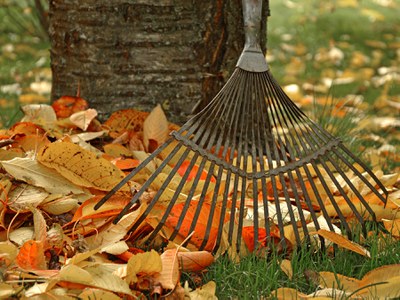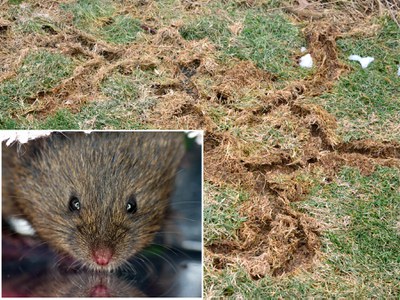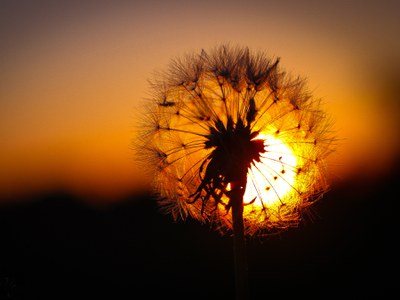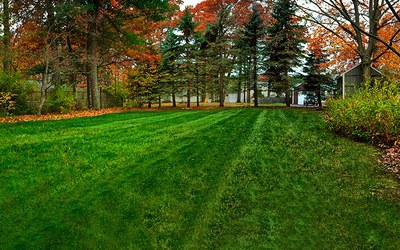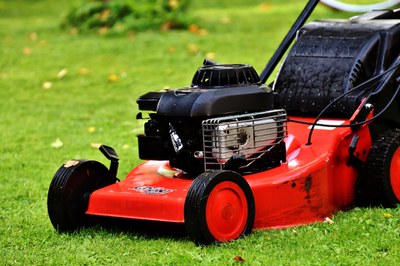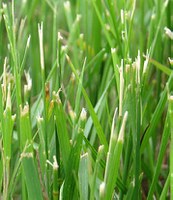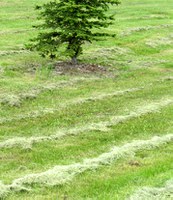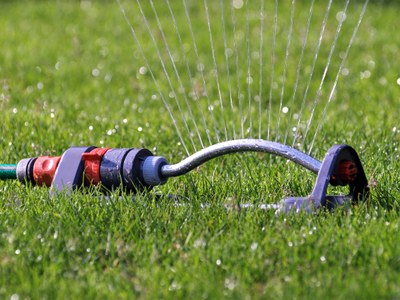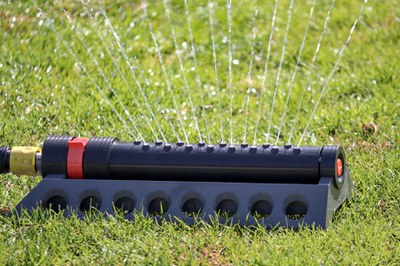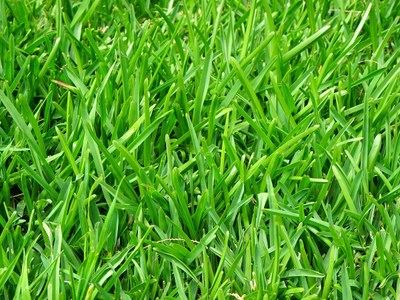Documents
Spraying Dandelions in Lawns
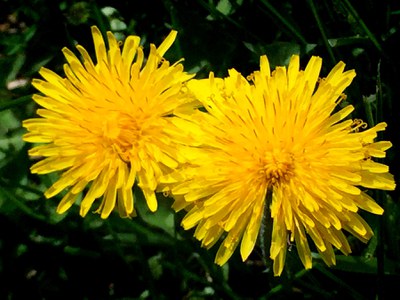 The most common perennial flower in North Dakota may be the dandelion.
The most common perennial flower in North Dakota may be the dandelion.
Some gardeners tolerate dandelions while other gardeners attack them with a vengeance.
Killing one dandelion is easy, but killing all of them is nearly impossible and a never-ending battle. A single dandelion plant can produce over 2,000 seeds!
Let’s focus on maintaining an attractive and healthy lawn with a judicious use of herbicides:
Choose the right herbicide. Dandelion, as well as clover, thistle and ground ivy, are broadleaf (non-grassy) weeds.
The most effective broadleaf-killing herbicides for lawns are Trimec formulations. These products consist of a combination of three herbicides (2,4-D, mecoprop and dicamba). Quinclorac is a recent addition to many broadleaf weed formulations. These formulations are powerful but also poisonous.
Dicamba is particularly effective, but it can persist in the soil and cause damage to nearby trees, shrubs and perennials. This is all the more reason why herbicides should be limited in their use.
Herbicides that control weeds in pastures and rangeland are commonly used in rural areas of North Dakota. These herbicides, including Milestone and Tordon, will kill weeds in residential lawns, but they may also damage trees, shrubs and other plants in your landscape.
Spray only when needed. These herbicides are poisonous. Use them only when necessary, and then only when most effective.
Herbicides are most effective when used in fall (not in spring). The key to killing weeds is to get the herbicide down into the roots.
In fall, weeds naturally channel their nutrients down into their roots in preparation for winter. If sprayed in fall, the weeds will naturally send the herbicide, along with their nutrients, down into the roots.
Herbicides sprayed in spring will not be as readily transported through a weed’s root system. Repeated applications may be required.
Use spot sprays. Instead of spraying your entire lawn, focus your sprays in the weedier areas of your lawn, spraying the weeds themselves. This will reduce your exposure to the toxic chemicals and save you money.
Spray under the right conditions. Drift from herbicide sprays may damage vegetables, flowers, trees and shrubs in your landscape.
Avoid spraying when winds exceed 5 MPH. Avoid spraying when temperatures approach 90 degrees or warmer. Drift may occur under foggy conditions.
When needed, cover or shield your desirable plants from nearby sprays.
Avoid spraying with a fine mist. Heavy droplets are less likely to volatilize.
Promote a thick, healthy lawn. Cut your turf tall. The tall blades will shade out the emerging weeds and prevent them from getting established.
Do not collect grass clippings. The clippings in your lawn can smother out emerging weed seedlings. The clippings can also promote a stronger, thicker turf by keeping the soil cool and moist, as well as recycling nutrients back into the soil.
Fertilizing your lawn can enhance its thickness and reduce the establishment of weeds.
Written by Tom Kalb, Extension Horticulturist, North Dakota State University. Photo courtesy of *creativ*contrasts.
Caring for Your Lawn in October
Days are getting shorter. We all know that winter is coming. It's time to prepare our lawn for the cold weather ahead of us.
The best time to improve our lawn has passed. September was the month to focus on lawn improvement.
Here are some tips on caring for your lawn in October:
Mulch or Rake Leaves?
Shred leaves with your mulching mower. The lawn will not suffocate from the mulched leaves as long as you can see the grass blades after mowing.
Thick layers of leaves must be raked, or the lawn will get smothered and rot. These piles of leaves are often found below maples and other large-leaved trees.
Final Mowing
A tall turf is bad over winter. It attracts voles (damage is shown) and becomes more susceptible to mold over winter. Cut your turf at a normal height or slightly lower (1.5–2.0 inches) the last time you mow.
Killing Weeds After Frost
Weeds can be sprayed after a frost if the leaves appear not to be damaged. The weeds must be active for the herbicide to be absorbed and move into the roots. Broadleaf herbicides with dicamba are effective. If you spray, do it ASAP.
Avoid spraying lawns that are suffering from significant drought stress. In this case, a spot spray of weeds is most appropriate.
Seeding
Don’t sow now; the seedlings won’t survive winter.
Wait to sow seed until November; these seeds will sprout next spring. Sow seed, lightly incorporate in soil, and irrigate once. This strategy is well known as "dormant seeding."
Fertilizing
Don't fertilize now. We do not want to encourage a burst of new, lush growth. Let's allow the lawn to harden itself and prepare for winter.
Winter is coming. Take a few moments to prepare your lawn before winter arrives. Your healthy lawn will come out of winter ready to green up and grow vigorously next spring.
Written by Tom Kalb, Extension Horticulturist, North Dakota State University. Photos were made available under Creative Commons licenses specified by the photographers: Peggy Choucair from Pixabay; BlueRidgeKitties; David L. Clement, University of Maryland, Bugwood.org; *Jyl*.
Hunting for Grubs
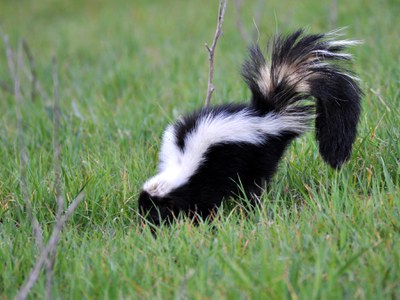 |
|
Skunk digging for grubs. |
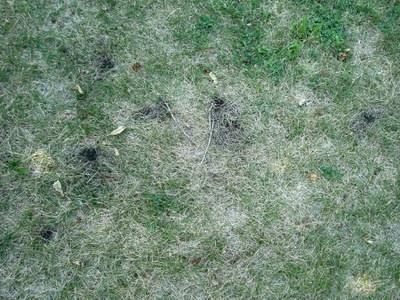 |
|
Skunks dig holes in lawns looking for grubs. Raccoons have been known to dig |
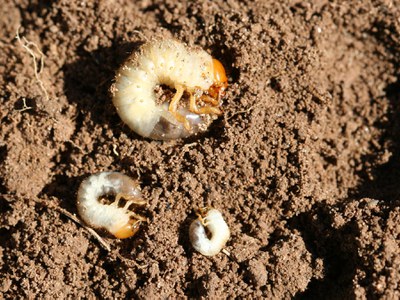 |
|
Grubs of June beetles. |
Do you have mysterious holes appearing in your lawn? You could have hungry skunks or raccoons visiting you at night. Once they find a grub-infested lawn, they will keep coming back for more.
You can stop the damage from skunks and raccoons by taking away their food. Kill the grubs with an insecticide, and the wildlife will hunt for grubs in someone else’s yard. Outdoor lighting or rags soaked with ammonia may help to repel skunks, too.
Before treating with an insecticide, make sure grubs are in your lawn. Do the “tug test.” Grab a handful of damaged turf and tug it up. If it comes up easily, this is likely due to grubs, which gnaw on turf roots.
Peel back the damaged turf. The grubs, if present, will be right near the surface. They will curl into a C-shape and be the length of about 0.5 to 1.0 inch.
It's common for grubs to be in a lawn. Three or more grubs per square foot near the soil surface are needed to warrant any chemical treatment.
Don't treat if you do not see the grubs. You are wasting your money on killing a pest that is not there. You may also be introducing an insecticide to the environment that is harmful to bees and other beneficial insects.
Among grub-killing chemicals, triclorfon and carbaryl act within days. These "curative" chemicals are applied when grub populations are severe and will persist only during the particular season they are applied (usually late spring or fall).
Imidacloprid and chlorantraniliprole are applied as a preventative in early summer to kill grubs in late summer and fall when many severe grub problems occur. They should not be applied now.
Make sure you mow your lawn before applying the insecticide. This will remove any weed flowers and protect bees from being harmed. Imadicloprid and carbaryl are particularly toxic to bees; chlorantraniliprole is not toxic to bees.
If you apply an insecticide, irrigate the chemical deeply to move it down to the grubs. Apply at least 0.5 inches of water as soon as possible after application.
The vast majority of lawns do not have harmful populations of grubs. A vigorous and healthy lawn can tolerate some grubs.
Milky disease spore (Bacillus popilliae) products are not effective at controlling grub species in our state.
Grub problems will begin to decline when the grubs start burrowing deeper to escape the winter cold. When the grubs go away, so will the skunks and raccoons.
Written by Tom Kalb, Extension Horticulturist. North Dakota State University. Photos courtesy of g.h.vandoorn; Irene Graves; Steven Katovich, Bugwood.org. Contributing source: Smitley, D., T. Davis and E. Hotchkiss. 2020. How to choose and when to apply grub control products for your lawn. Michigan State University.
Let's Grow a Great Lawn!
If you want a great lawn, now is the time to take action.
September is the best month to sow seed, fertilize, kill weeds and aerate your lawn.
Here are some things you should do this month.
Fill in bare spots. Now through mid-September is the best time to sow grass. The seeds will germinate quickly in the warm soil. As a bonus, weed seedlings rarely germinate in the fall, so we don’t have to worry about them. Awesome!
Choose a high-quality seed mix with a blend of grasses. Most seed mixes will include cultivars of Kentucky bluegrass, fine/red fescues and perennial ryegrass.
Kentucky bluegrass is a hardy grass that should be the predominant grass for sunny areas. The fine/red fescues are best for shade. Perennial ryegrass is a nice addition to a mix because it germinates rapidly and stabilizes the soil while the other lawn grasses emerge.
This also is a terrific time to lay sod. It will quickly “knit” into the soil.
Fertilize. Fall is the most important time to fertilize your lawn. Lawns grow vigorously and grow most of their roots this time of year. If you fertilize your lawn only once a year, do it in September. Labor Day is a good date to target for fertilizing.
Fertilizer has three major components: nitrogen, phosphate and potash. Nitrogen is most important for turf growth. Look for a fertilizer that has more than 20% nitrogen.
Select a fertilizer with slow-release nitrogen. This fertilizer will promote the growth of roots this fall and provide for a vigorous greening up of the lawn in the spring.
Phosphate is least important because it is already abundant in most soils. Potash will help the lawn become hardy for winter. Look for a “winterizer” fertilizer that has at least 10% potash.
Do not fertilize your lawn if it has not come out of its summer dormancy. You may burn it.
Kill broadleaf weeds. Mid to late September is the best time to kill broadleaf weeds, including dandelions, thistles and clover. As days get shorter, the weeds begin moving nutrients down into their roots to prepare for winter.
This is good for us because a herbicide sprayed on a weed at this time will be absorbed and naturally sent down into the weed’s root system, killing the entire plant. Bye, bye weed!
Aerate. The vast majority of lawns never need to be aerated, but all lawns will enjoy it. September is the best time to aerate the lawn. This is when roots grow, and aeration promotes new roots. Compacted ground (walkways and heavy soils) especially will benefit from aeration.
Hollow tine or core aerators are recommended because they create air pockets by removing plugs of soil/thatch (cores) from the turf. Let the cores dry for a couple of days and then mow to break them up.
Remove cores as deeply as possible (about 3 inches) when aerating. You obtain the best results when the soil is slightly moist but not wet. If the soil is dry, irrigate it one or two days before aerating.
You can fertilize after a core aeration to encourage the recovery of the turf. Lawns may be overseeded after aeration, too.
Now is the time for lawn improvement. Let’s get busy!
Written by Tom Kalb, Extension Horticulturist, North Dakota State University. Photo courtesy of Timothy Valentine.
Tips on Watering Your Lawn
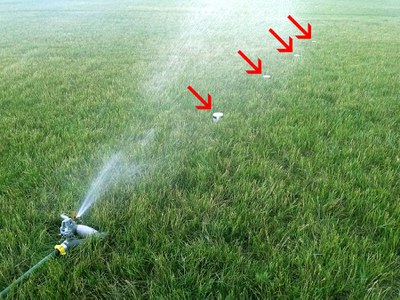
Can you enjoy a green lawn in summer without an expensive water bill?
Let’s discuss how you can make every drop of water count.
To keep your lawn green and growing, it needs about 1 inch of water per week from you, rainfall or a combination of both.
To measure how much is 1 inch of water, set a group of flat-bottomed cups at 5- to 10-foot intervals from the base of your sprinkler to the edge of its reach. Measure the time an inch of water takes to fall in the cups. Use this as your base time.
Water deeply. Giving your lawn a big gulp of water is better than giving it a series of sips. Roots grow where the water is. If you water deeply, you will develop a deep root system. On the other hand, if you only sprinkle the surface of the soil, you will create a shallow root system.
If you have a clay soil, irrigate only once or twice a week. Sandy soils can’t hold a full inch of water, so we will need to split the application to two or three times a week.
Split applications are also a good idea if you see water running off from the lawn (for example, on a sloped landscape). We want the water to be absorbed and not to run off.
Water in the early morning. The grass plants will be active and will absorb the water they need. Any extra water will evaporate, keeping the grass blades dry and preventing diseases. Watering during the middle of the day is not recommended since much of the water you apply will evaporate before the plants absorb it. Watering is the evening is not recommended since the lawn will stay wet all night, leading to diseases.
Mow properly. This makes a big difference. Mow tall and let the grass clippings fall. Tall turf naturally develops a deeper root system. The tall grass blades and the grass clippings will shade the soil, keeping it cooler and conserving moisture. The first lawns that turn yellow in a neighborhood are lawns that are cut short and where clippings are collected.
Monitor your automatic timer. These “set it and forget it” systems are convenient, but they sometimes irrigate the lawn when it’s not needed. Only irrigate when the lawn is dry. Don’t irrigate when it’s raining or when rain is expected. Rain sensors and soil moisture sensors are available that prevent irrigation systems from running when rain is falling or when the soil is moist.
Improve your soil. Adding organic matter can help. The next time you aerate the lawn, fill in the holes with some compost or peat moss. In clay soils, this organic matter will open the soil, helping water infiltrate rather than run off. In sandy soils, this organic matter will help the soil hold onto the water before it drains away.
Use the natural alternative. You have the option of not watering your lawn at all. Your lawn will turn yellow gradually and go dormant. Going dormant under intense heat is natural for lawns. Lawns will turn green again in the fall when temperatures cool.
Whether you irrigate your lawn or not, you can have a healthy lawn without breaking your bank account. Irrigate only when needed and make every drop count.
Written by Tom Kalb, Extension Horticulturist, North Dakota State University.
Winterize Your Lawn
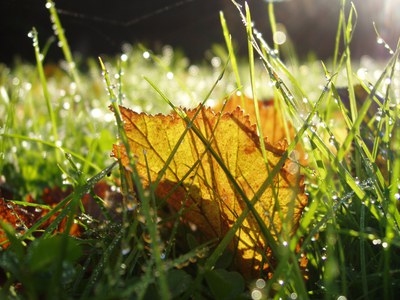 Is your lawn prepared for winter?
Is your lawn prepared for winter?
Take a few moments now to care for your lawn and you will be rewarded with a healthier turf next year.
Mulching/Raking Leaves. Most gardeners manage their leaves by shredding them with a mulching mower. The lawn will not suffocate from the mulched leaves as long as you can see the grass blades after mowing. Thick layers of leaves must be raked; otherwise the lawn could be smothered and suffer disease problems next spring.
Mowing. Mow your turf after it has stopped growing. A tall turf is bad during winter. The tall grass blades will attract voles and other critters. A tall turf gets matted down by snow and becomes susceptible to diseases.
Fertilizing. Fertilizing the lawn this late in fall is not recommended. Our lawns are going dormant and will absorb very little of the nutrients this late in the season. Any fertilizer that remains on frozen ground is at risk of running off the land. Let’s wait to fertilize in spring.
Killing Weeds. Weeds should be sprayed when they are actively growing. Mid- to late September was the most effective time to control weeds. Weeds can be sprayed after a frost if the leaves appear not to be damaged.
Watering. Fall 2019 has been extremely wet. Lawns do not need to be irrigated.
Sowing Seed. The best time to sow grass seed is in early fall (August 15–September 20). We missed that opportunity.
You can still “dormant seed” your lawn in late October or November. The seed will stay dormant through winter and then germinate in spring. Dormant seeding works best in level sites where soil will not wash away during the spring thaw.
If you dormant seed, do not use a crabgrass preventer next spring. The crabgrass herbicide will kill all germinating grass seedlings, including your desirable lawn grass seedlings.
Written by Tom Kalb, Extension Horticulturist, North Dakota State University. The photo was made available under Creative Commons licenses specified by the photographer, all allowing for adaptation, modification or building upon: Auntie P.
How to Mow Your Lawn
Do you want a beautiful landscape? Of course! Start with a healthy lawn. One of the most important factors in growing a healthy lawn is to mow it properly. Here's how:
Cut your lawn tall. A tall turf will:
-- shade the soil and protect it from summer’s heat;
-- develop a deep root system; and
-- reduce weed populations since the tall grass blades shade out and smother emerging weed seedlings.
Cut your lawn between 2.5 and 3.5 inches. Tall heights are especially beneficial during summer and for low-maintenance conditions. The first lawns that turn yellow in summer are the lawns that are cut too short.
Follow the “one-third rule.” Avoid removing more than one-third of the grass blade at any time. Cutting too much of the grass will slow its regrowth. It will expose the soil more, which leads to drought stress and the establishment of more weeds. Using this “one-third rule” as a guide, if you kept your lawn at 3 inches, you would cut it when it is no more than 4.5 inches tall.
Thus, the timing for mowing your lawn is dependent on its growth. You may need to mow every 5 days in spring, but every 5 weeks in summer.
Let the grass clippings fall. You don’t need to collect clippings. Your lawn wants those clippings. The clippings will shade the soil and conserve moisture. The clippings will recycle nutrients to the soil—it is like getting a free fertilization every year.
If you mow regularly, clippings will not create a thatch problem. Clippings are mainly water and they will quickly decompose.
The exception is when your lawn gets neglected and grows very tall. Excessively tall grass when mowed can gather in clumps on the lawn (see photo). This can smother the turf. Tall blades can get more fibrous and become slower to decompose—this can lead to an accumulation of thatch. In these cases, it is wise to collect these clippings.
Mow when grass is dry. This will reduce clumping and help to mulch the grass blades finer.
Use a sharp mower blade. A sharp blade will make a clean cut. Dull blades will tear the tips of leaf blades (see photo). The damaged leaf blades will develop a brown tip. Frayed blades lose water more quickly and become more susceptible to diseases. Depending on how much turf you cut, you may need to sharpen or replace your blade every year.
Written by Tom Kalb, Extension Horticulturist, North Dakota State University.
Super Summer Lawns
Lawns in North Dakota hate the heat. The grass turns yellow and goes dormant as temperatures rise.
It’s okay to let your lawn go dormant—it’s natural. But if you don’t like looking at golden grass, let’s talk about summer lawn care:
Water deeply. It’s better to give your lawn a big gulp of water rather than a series of sips. That’s because roots grow where the water is. If you give the lawn a big gulp and water deeply, you will develop a deep root system. On the other hand, if you only sprinkle the surface of the soil, you will create a shallow root system.
Lawns need about 1.0 to 1.5 inches of water per week, either from you or rainfall. If you have a clay soil, irrigate only once or twice a week. Sandy soils can’t hold a full inch of water. These soils should receive about 0.5 inch of water two or three times per week when needed.
Watering in the early morning is best. The grass plants are active and will absorb the water they need. Any extra water will evaporate, keeping the grass blades dry and preventing diseases. Watering during the middle of the day is not recommended since much of the water you apply will evaporate before the plants absorb it. Watering is the early evening is not recommended since the lawn will stay wet all night, leading to diseases.
Mow your turf tall—the taller the better. A tall turf will shade the soil, keeping it cool. A taller turf naturally develops a deeper root system, protecting your lawn against drought damage. The first lawns in the neighborhood that turn yellow are lawns that are mowed short.
Your grass will be healthier and less thirsty if you let your grass clippings fall to the ground. These clippings will shade the soil surface, keeping it cool.
Avoid using weed killers on your lawn in the summer. You will have better success at killing weeds in September. Herbicides add extra stress to lawns, which are already under stress from the heat. There is also the risk of the herbicide drifting into your garden, causing these plants to curl and/or die.
Don’t be too worried about grubs or other insects. Less than 5% of our lawns need treatments for insect pests. Before treating, make sure you actually have a problem.
Grubs are the most common pest. Dig a couple inches deep along the edges of emerging brown spots. The grubs, which are creamy white in color and the size of your pinkie finger, will be munching on the grass roots. A few grubs are normal; treatments are not recommended until you find three or more grubs per square foot.
Don’t burn the lawn with fertilizer. Heat-stressed lawns do not need fertilizer, but a light fertilization might be necessary if you irrigate all summer. Use about one-half the suggested rate. Organic fertilizers are especially useful in summer since they are less likely to burn the grass.
Whether or not you actively take care of your lawn in summer, expect the lawn to wake up when temperatures cool off. Autumn is the best time to reseed, kill weeds, fertilize and aerate the lawn.
Written by Tom Kalb, Extension Horticulturist, North Dakota State University.
Super Summer Lawns
Lawns in North Dakota hate the heat. The grass turns yellow and goes dormant as temperatures rise.
It’s okay to let your lawn go dormant—it’s natural. But if you don’t like looking at golden grass, let’s talk about summer lawn care:
Water deeply. It’s better to give your lawn a big gulp of water rather than a series of sips. That’s because roots grow where the water is. If you give the lawn a big gulp and water deeply, you will develop a deep root system. On the other hand, if you only sprinkle the surface of the soil, you will create a shallow root system.
Lawns need about 1.0 to 1.5 inches of water per week, either from you or rainfall. If you have a clay soil, irrigate only once or twice a week. Sandy soils can’t hold a full inch of water. These soils should receive about 0.5 inch of water two or three times per week when needed.
Watering in the early morning is best. The grass plants are active and will absorb the water they need. Any extra water will evaporate, keeping the grass blades dry and preventing diseases. Watering during the middle of the day is not recommended since much of the water you apply will evaporate before the plants absorb it. Watering is the early evening is not recommended since the lawn will stay wet all night, leading to diseases.
Mow your turf tall—the taller the better. A tall turf will shade the soil, keeping it cool. A taller turf naturally develops a deeper root system, protecting your lawn against drought damage. The first lawns in the neighborhood that turn yellow are lawns that are mowed short.
Your grass will be healthier and less thirsty if you let your grass clippings fall to the ground. These clippings will shade the soil surface, keeping it cool.
Avoid using weed killers on your lawn in the summer. You will have better success at killing weeds in September. Herbicides add extra stress to lawns, which are already under stress from the heat. There is also the risk of the herbicide drifting into your garden, causing these plants to curl and/or die.
Don’t be too worried about grubs or other insects. Less than 5% of our lawns need treatments for insect pests. Before treating, make sure you actually have a problem.
Grubs are the most common pest. Dig a couple inches deep along the edges of emerging brown spots. The grubs, which are creamy white in color and the size of your pinkie finger, will be munching on the grass roots. A few grubs are normal; treatments are not recommended until you find three or more grubs per square foot.
Don’t burn the lawn with fertilizer. Heat-stressed lawns do not need fertilizer, but a light fertilization might be necessary if you irrigate all summer. Use about one-half the suggested rate. Organic fertilizers are especially useful in summer since they are less likely to burn the grass.
Whether or not you actively take care of your lawn in summer, expect the lawn to wake up when temperatures cool off. Autumn is the best time to reseed, kill weeds, fertilize and aerate the lawn.
Written by Tom Kalb, Extension Horticulturist, North Dakota State University. Photo courtesy of Manfred Richter from Pixabay.
Memorial Day: A Great Time to Fertilize Your Lawn
Did you fertilize your lawn yet? Don’t feel bad if you didn’t. The best time to feed your lawn in spring is near Memorial Day, not earlier.
The key to a thick, healthy turf is a strong root system. When your turf wakes up after winter, it naturally wants to develop roots and build up its energy reserves. If you fertilize early in spring, your lawn will skip this phase and immediately go to producing more grass blades.
Lawns fertilized early in spring may appear to be robust since they are mowed more often, but the individual grass plants are drawing from their limited energy reserves. This makes the lawn more susceptible to stress from diseases and summer heat.
Its better to wait until Memorial Day. Let your turf focus on root growth in early spring. Once temps warm up in mid-May, the plants will naturally change its focus to blade growth. A fertilization around Memorial Day will support this growth, maintain food reserves in the plants, and prepare the turf for the stresses of summer.
A few other quick points:
- Use a lawn fertilizer that contains some slow-release nitrogen. Examples include isobutylidene diurea (IBDU), polymer-coated urea, sulfur-coated urea and organic sources. This will gradually feed the lawn for several weeks.
- Irrigate your lawn after fertilizing. This increases the effectiveness of the fertilizer and prevents fertilizer from running off the surface after a thunderstorm.
- Apply the fertilizer in two directions (for example, north/south and then east/west). This will give you more uniform coverage and prevent striping.
- Lawns are generally fertilized at the rate of 1.0 pounds of actual nitrogen per 1000 square feet. Shady areas grow slower and require less fertilizer.
- Follow the instructions on the bag.
Source: Rose, C.J., B.P. Horgan and R.J. Mugaas. Fertilizing lawns. University of Minnesota. Accessed online on May 25, 2018.
Loving Your Lawn
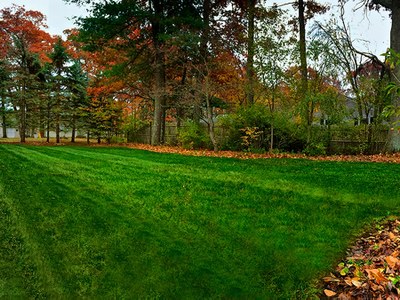 If you want a great lawn, now is the time to take action.
If you want a great lawn, now is the time to take action.
Early September is the best time to fertilize your lawn. The secret to growing a lush lawn is to develop a thick root system. Your lawn grows most of its roots in fall. Fertilize now to develop more roots.
A soil test can indicate the best fertilizer for your lawn, but a standard winterizer lawn fertilizer (30-0-10 or something similar) works well in most cases.
September is the best time to control perennial weeds (thistle, dandelion and ground ivy). The key to killing these weeds is to get the herbicide down into their roots. In fall, weeds channel their nutrients down into their roots to prepare for winter. If we spray a weed in mid- to late September, it will channel the herbicide (along with its nutrients) down into its roots. Goodbye weed!
The test of a true lawn lover is whether or not they aerate their lawn. I think a lawn receiving an aeration is comparable to a person receiving a massage. Does it feel good? Yes. Do most of us actually need it? Not really.
The vast majority of lawns never need to be aerated, but they all will enjoy it. September is the best time to aerate the lawn. This is when roots grow and aeration promotes new roots. Compacted ground (walkways and heavy soils) and turf with a thick thatch layer (over 1 inch) will benefit most.
Hollow tine or core aerators are recommended because they create air pockets by removing plugs of soil/thatch (cores) from the turf. Let the cores dry for a couple days and then mow to break them up. Remove cores as deep as possible (about three inches) when aerating. Best results are obtained when the soil is slightly moist but not wet. If the soil is dry, irrigate it one or two days before aerating.
You can fertilize after a core aeration to encourage the recovery of the turf. Lawns may be overseeded after aeration, too. Now through mid-September is the best time to overseed a lawn. The ground is warm and the seed will germinate quickly. Weed seedlings are a threat to new sowings, but weeds are less likely to germinate in fall than spring.
Solid tine aerators, spikers and spiked shoes can be used for overseeding but they do a poor job of aerating. They actually compact the ground by pushing soil down when they create their holes.
Vertical mowers (dethatchers) can be used to remove excessive thatch, and September is the best time for dethatching. Try to avoid cutting into the soil with the blades. Rake away the debris. Overseeding can be done to fill in any gaps created by the dethatching.
Written by Tom Kalb, Extension Horticulturist, North Dakota State University. Published in the NDSU Yard & Garden Report, August 31, 2016. The photo was made available under a Creative Commons license specified by the photographer: Timothy Valentine.





